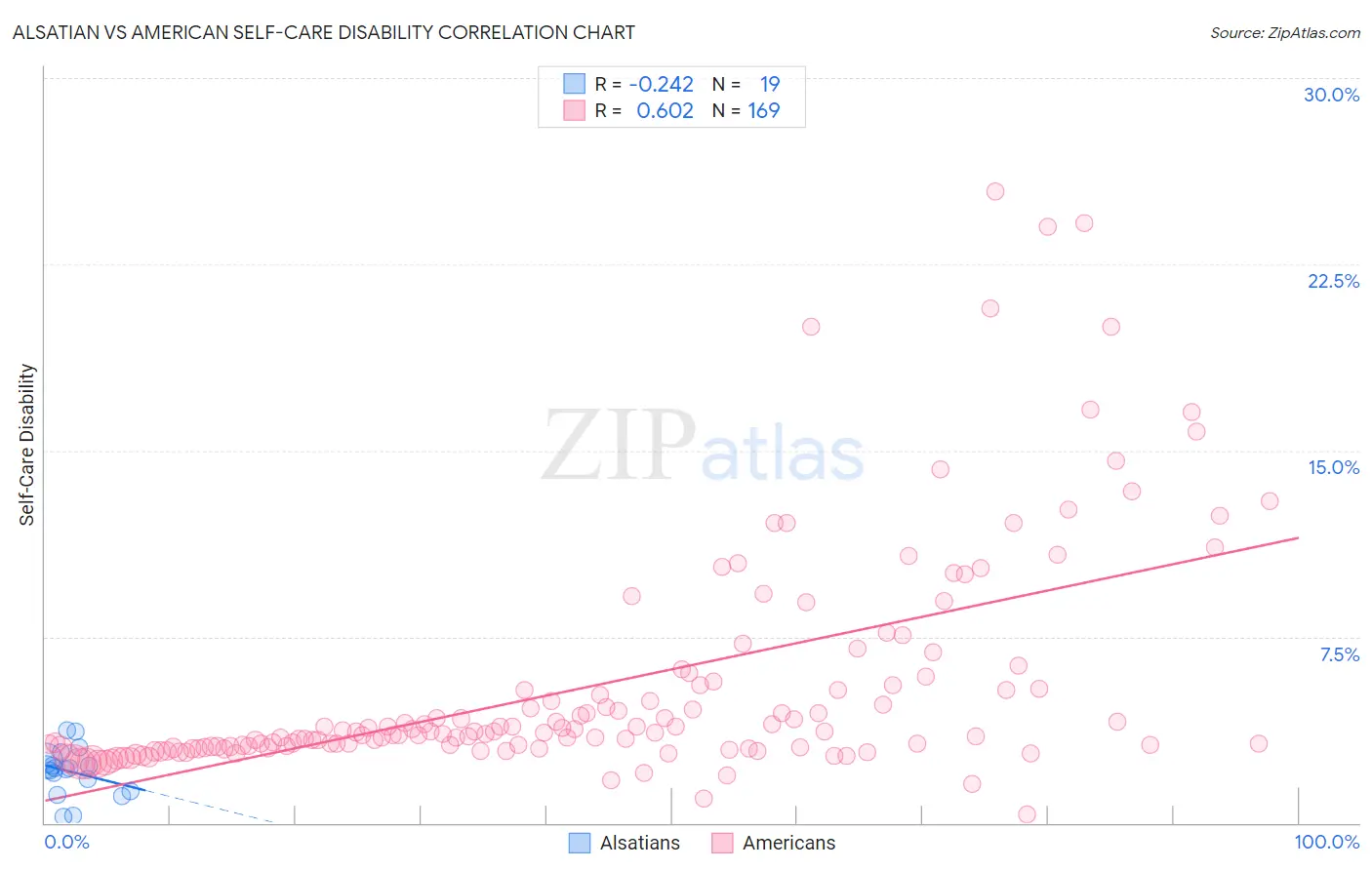Alsatian vs American Self-Care Disability
COMPARE
Alsatian
American
Self-Care Disability
Self-Care Disability Comparison
Alsatians
Americans
2.4%
SELF-CARE DISABILITY
94.9/ 100
METRIC RATING
103rd/ 347
METRIC RANK
2.8%
SELF-CARE DISABILITY
0.0/ 100
METRIC RATING
298th/ 347
METRIC RANK
Alsatian vs American Self-Care Disability Correlation Chart
The statistical analysis conducted on geographies consisting of 82,671,639 people shows a weak negative correlation between the proportion of Alsatians and percentage of population with self-care disability in the United States with a correlation coefficient (R) of -0.242 and weighted average of 2.4%. Similarly, the statistical analysis conducted on geographies consisting of 579,144,180 people shows a significant positive correlation between the proportion of Americans and percentage of population with self-care disability in the United States with a correlation coefficient (R) of 0.602 and weighted average of 2.8%, a difference of 16.1%.

Self-Care Disability Correlation Summary
| Measurement | Alsatian | American |
| Minimum | 0.22% | 0.36% |
| Maximum | 3.7% | 25.5% |
| Range | 3.5% | 25.1% |
| Mean | 2.1% | 5.5% |
| Median | 2.2% | 3.6% |
| Interquartile 25% (IQ1) | 1.3% | 3.0% |
| Interquartile 75% (IQ3) | 2.5% | 5.5% |
| Interquartile Range (IQR) | 1.2% | 2.5% |
| Standard Deviation (Sample) | 0.97% | 4.6% |
| Standard Deviation (Population) | 0.94% | 4.6% |
Similar Demographics by Self-Care Disability
Demographics Similar to Alsatians by Self-Care Disability
In terms of self-care disability, the demographic groups most similar to Alsatians are Croatian (2.4%, a difference of 0.030%), Bhutanese (2.4%, a difference of 0.10%), Carpatho Rusyn (2.4%, a difference of 0.13%), Immigrants from Indonesia (2.4%, a difference of 0.14%), and British (2.4%, a difference of 0.15%).
| Demographics | Rating | Rank | Self-Care Disability |
| Immigrants | Chile | 96.7 /100 | #96 | Exceptional 2.4% |
| Swiss | 96.6 /100 | #97 | Exceptional 2.4% |
| Immigrants | Poland | 96.4 /100 | #98 | Exceptional 2.4% |
| Immigrants | Israel | 96.1 /100 | #99 | Exceptional 2.4% |
| Europeans | 95.8 /100 | #100 | Exceptional 2.4% |
| Immigrants | Scotland | 95.7 /100 | #101 | Exceptional 2.4% |
| Croatians | 95.0 /100 | #102 | Exceptional 2.4% |
| Alsatians | 94.9 /100 | #103 | Exceptional 2.4% |
| Bhutanese | 94.5 /100 | #104 | Exceptional 2.4% |
| Carpatho Rusyns | 94.4 /100 | #105 | Exceptional 2.4% |
| Immigrants | Indonesia | 94.3 /100 | #106 | Exceptional 2.4% |
| British | 94.3 /100 | #107 | Exceptional 2.4% |
| Greeks | 94.1 /100 | #108 | Exceptional 2.4% |
| Slovenes | 94.1 /100 | #109 | Exceptional 2.4% |
| Immigrants | Africa | 93.7 /100 | #110 | Exceptional 2.4% |
Demographics Similar to Americans by Self-Care Disability
In terms of self-care disability, the demographic groups most similar to Americans are Immigrants from Guyana (2.8%, a difference of 0.090%), West Indian (2.8%, a difference of 0.12%), Immigrants from Portugal (2.8%, a difference of 0.20%), Immigrants from Fiji (2.8%, a difference of 0.56%), and Barbadian (2.7%, a difference of 0.63%).
| Demographics | Rating | Rank | Self-Care Disability |
| Guyanese | 0.0 /100 | #291 | Tragic 2.7% |
| Central American Indians | 0.0 /100 | #292 | Tragic 2.7% |
| Belizeans | 0.0 /100 | #293 | Tragic 2.7% |
| Blackfeet | 0.0 /100 | #294 | Tragic 2.7% |
| Barbadians | 0.0 /100 | #295 | Tragic 2.7% |
| Immigrants | Portugal | 0.0 /100 | #296 | Tragic 2.8% |
| West Indians | 0.0 /100 | #297 | Tragic 2.8% |
| Americans | 0.0 /100 | #298 | Tragic 2.8% |
| Immigrants | Guyana | 0.0 /100 | #299 | Tragic 2.8% |
| Immigrants | Fiji | 0.0 /100 | #300 | Tragic 2.8% |
| Pima | 0.0 /100 | #301 | Tragic 2.8% |
| Immigrants | St. Vincent and the Grenadines | 0.0 /100 | #302 | Tragic 2.8% |
| Immigrants | Belize | 0.0 /100 | #303 | Tragic 2.8% |
| Cree | 0.0 /100 | #304 | Tragic 2.8% |
| Immigrants | West Indies | 0.0 /100 | #305 | Tragic 2.8% |